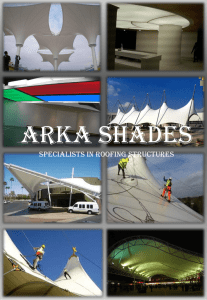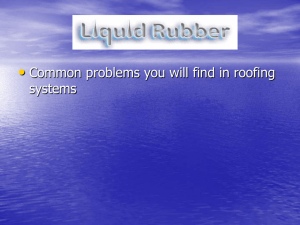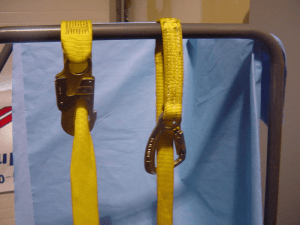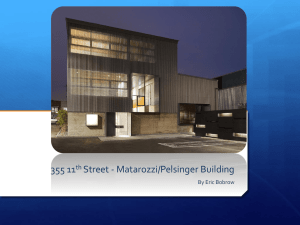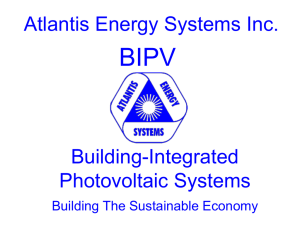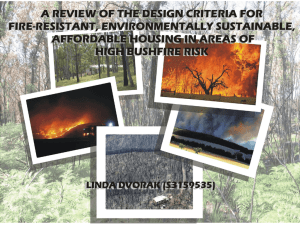Balancing Modified Bitumen with High SRI Ratings
advertisement
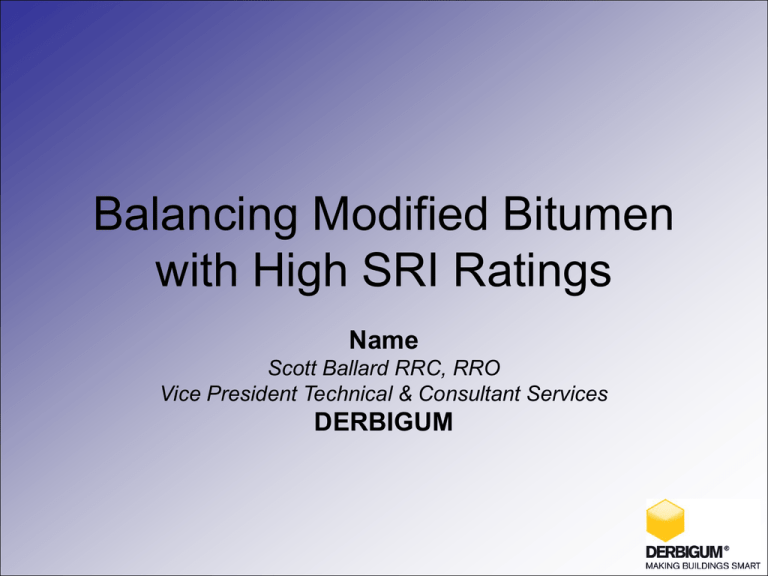
Balancing Modified Bitumen with High SRI Ratings Name Scott Ballard RRC, RRO Vice President Technical & Consultant Services DERBIGUM AIA/CES • DERBIGUM is a Registered Provider with The American Institute of Architects Continuing Education Systems. • Credit earned on completion of the program will be reported to CES Records for AIA members. • Certificates of Completion for non-AIA members are available on request. AIA/CES • This program is registered with the AIA/CES for continuing education. • As such, it does not include content that may be deemed or construed to be an approval or endorsement by the AIA of any material of construction or any method or manner of handling, using, distributing, or dealing in any material or product. • Questions related to specific materials, methods, and services will be addressed at the conclusion of this presentation. Learning Objectives Upon completion of this program, participants will be able to: • Define reflectivity, emissivity and Solar Reflectance Index (SRI). • Identify some of the key organizations in setting the standards for a “cool roof”. • Identify some of the advantages of a high SRI roofing system. • Understand the importance of balancing high SRI with sustainability and longevity. • Discuss additional design consideration for a high performance roofing system. • Review alternative systems. Defining the Cool Roof • Reflectivity – The ratio of the energy of a wave reflected from a surface to the energy possessed by the wave striking the surface. • Emissivity – The ratio of the radiation emitted by a surface to the radiation emitted by a blackbody at the same temperature. Defining the Cool Roof • Solar Reflectance Index (SRI) – A measure of the roof's ability to reject solar heat, as shown by a small temperature rise. – Standard black (reflectance 0.05, emittance 0.90) is 0 and a standard white (reflectance 0.80, emittance 0.90) is 100. – By definition, particularly hot materials can even take slightly negative values, and particularly cool materials can even exceed 100. Setting and Reporting the Standards • Cool Roof Ratings Council (CRRC) – The CRRC was created in 1998. – Develop accurate and credible methods for evaluating and labeling the solar reflectance and thermal emittance of roofing products. – Disseminate the information to all interested parties. Setting and Reporting the Standards • EPA Energy Star – ENERGY STAR qualified roof products (0.65 reflectivity) reflect more of the sun's rays. – ENERGY STAR qualified roof products can help reduce the amount of air conditioning needed in buildings. – ENERGY STAR qualified roof products can reduce peak cooling demand by 10–15 percent . Setting and Reporting the Standards • Title 24 – Cool roofs are highly reflective (0.70), highly emissive (0.65) roofing materials that stay 50 to 60 degrees F cooler. – For building owners they can cut maintenance costs and increase the life expectancy of the roof. – A calculator is now available to quickly determine the energy-equivalent R-value of insulation needed to meet Title 24 requirements. Setting and Reporting the Standards • Leadership in Energy & Environmental Design (LEED) – The LEED Green Building Rating System is a voluntary standard. – LEED NC requires 75% of the roof to be a cool roof. – The SRI value (minimum 78) is calculated according to ASTM E 1980, Setting and Reporting the Standards • American Society of Heating, Refrigerating and AirConditioning Engineers (ASRAE) – ASHRAE 90.1 defines a cool roof as having a minimum solar reflectance of 0.70 and minimum thermal emittance of 0.75. – Allows reduced roof insulation (U-factor) if a cool roof is used. – These documents are not mandatory or enforceable until a jurisdiction adopts the documents as part of regulation or law. • Proposed standard 189.1 – To be SRI 78 (low-slope)or cool roof. – A “cool roof” is just one of the potential strategies for reducing heat gain to a building structure. – Modeled after LEED NC v. 2.2. Setting and Reporting the Standards • State, County & City Regulations – Some “Talk the Talk” • Atlanta & Houston Studies – Others “Walk the Walk” • California & Chicago • Utility Companies – Incentives or Rebates. – Improvement over existing reflectivity or SRI. – Some require minimum insulation in coordination with cool roof. Setting and Reporting the Standards • Laboratory Studies – Oak Ridge National Laboratory • Reflectivity research, begun in the summer of 1997 • Typical results are that reflectance is reduced by about 0.1 to 0.3. • Most recent studies explored effects of R-Value to offset energy in Northern climates. – Lawrence Berkeley National Laboratory • The Heat Island Group. • Buildings used up to 40% less energy for cooling than buildings with darker roofs. Why Cool Roofing • Heat Island Effect – A "dome" of elevated temperatures over an urban area. – Caused by structural and pavement heat fluxes, and pollutant emissions. – The annual mean air temperature of a city with 1 million people or more can be 1.8–5.4°F (1–3°C) warmer than its surroundings. Why Cool Roofing • Heat Island Effect – In the evening, the difference can be as high as 22°F (12°C). – Heat islands can affect communities by increasing: • Summertime peak energy demand; • Air conditioning costs; • Air pollution; • Greenhouse gas emissions; • Heat-related illness and mortality; • Water quality. Why Cool Roofing • Heat Island Effect – Original Atlanta Study focus: • The development of the urban heat island phenomenon. • Change on air quality. • Surface energy budget characteristics across the Atlanta urban landscape. Why Cool Roofing • Heat Island Effect – New Atlanta Study • The study indicates a connection between the intensity of the 2008 urban Atlanta tornado and the heat island effect. • Hot, dry urban conditions may have led to a larger discrepancy with the surrounding atmospheric conditions, enhancing stability and thus intensifying the storm as it approached the city. Why Cool Roofing • Heat Island Effect – Ambient Temperature at Night • Normal forests and fields in Georgia during the day would be a mustard green, not the hot red that is seen in the upper photo. • At night it would be a cool green, not the mustard green/orange seen in the bottom photo. • This has nothing to do with global warming and everything to do with land use changes Why Cool Roofing • Heat Island Effect – Urban Heat Related Deaths • Compared to rural areas, cities experience higher rates of heat-related illness and death. • Heat islands can amplify extreme hot weather events, which can cause heat stroke and lead to physiological disruption, organ damage, and even death. • Especially in vulnerable populations such as the elderly. Why Cool Roofing • Energy Savings – Quantify Savings Potential • A lower temperature means the roof conducts less heat into the building, which translates into a smaller cooling load. • A reasonable average savings expectation for a typical application of cool roofing is in the range of 10 percent to 30 percent of the cooling energy required. • This range might equate to a total building electric bill reduction of 3 percent to 10 percent. Why Cool Roofing • Energy Savings – Peak Energy Production Savings • Because cool roofs reduce air-conditioning use during the day’s hottest periods, the associated energy savings occur when the demand for electricity is at its peak. • Use of cool roofs reduces the stress on the energy grid during hot summer months and helps avoid shortages that can cause blackouts or brownouts. • For building owners that pay for their energy based on the time of use, they save energy when it is at its most expensive. Modified Bitumen Reflective Options • Coated Granules • Paint Chips • Laminate Sheets • Integrated Reinforcement Sheet Modified Bitumen Reflective Options • Coated Granules – Pros • High initial reflectivity – Cons • Granule loss • Recoat needed 4-7 years • Asphalt oil migration • Paint Chips – Pros • Factory applied – Cons • Light refraction • Flaking • Asphalt oil migration Modified Bitumen Reflective Options • Laminate Sheet – Pros • High initial reflectivity • Factory applied • Increased puncture resistance – Cons • Wrinkled appearance • Durability question • Integrated Surface – Pros • High initial reflectivity • Factory applied • Increased puncture resistance • PH Neutral impact on H2O • Opportunity for recover • Foot traffic protection – Cons • Application time • Application care SRI Not the Whole Story • Life Cycle Costs – Proven In Place Performance • Membrane Thickness • Redundancy White Cap Sheet - 140 mils Base Sheet - 120 mils Adhesive 30 mils/layer SRI Not the Whole Story • Life Cycle Cost DERBIGUM Sustainable Roofing Program Life Cycle Cost Analysis PROJECT INFORM ATION Project Name Square Feet of Project Sustainable Guaranty Length, Years (30 or 40) DERBIGUM System Type, Initial DERBIGUM System Cost, Initital per Square Foot DERBIGUM Recover Cost, per Square Foot Alternative System Type Altenative System Cost, Initial per Square Foot Alternative System Life Span (15 or 20) Annual Inspection Cost, Base Rate Inflation Rate Joe The Owner 75,000 40 $9.00 $4.00 $7.50 20 $750.00 5% SRI Not the Whole Story • Life Cycle Cost CURRENT COST ANALYSIS DERBIGUM System Life Cycle Cost Analysis Initital Roof Replacement Cost Annual Inspection Cost Maintenance & Repair Cost DERBIGUM Sustainable Membrane Cost DERBIGUM System Total Cost Alternative System Life Cycle Cost Analysis Initital Roof Replacement Cost Maintenance & Repair Cost Alternative System Roof Replacement Cost Alternative System Total Cost Total Savings with DERBIGUM System Lump Sum Square Foot $675,000.00 $9.00 $15,000.00 $0.20 $300,000.00 $990,000.00 $4.00 $13.20 $562,500.00 $7.50 $562,500.00 $1,125,000.00 $7.50 $15.00 $135,000.00 $1.80 SRI Not the Whole Story • Life Cycle Cost INFLATION ADJUSTED ANALYSIS DERBIGUM Life Cycle Cost Analysis Initital Roof Replacement Cost Annual Inspection Cost Maintenance & Repair Cost DERBIGUM Sustainable Membrane Cost DERBIGUM System Total Cost Alternative System Life Cycle Cost Analysis Initital Roof Replacement Cost Maintenance & Repair Cost Alternative System Roof Replacement Cost Alternative System Total Cost Total Savings with DERBIGUM System Lump Sum Square Foot $675,000.00 $9.00 $19,750.00 $0.26 $758,085.06 $1,452,835.06 $10.11 $19.37 $562,500.00 $7.50 $1,421,409.48 $1,983,909.48 $18.95 $26.45 $531,074.43 $7.08 SRI Not the Whole Story • But it is a New Chapter to the Life Cycle Cost Story 20 year Life Cycle Cost Black Roof Surface White Roof Surface Roof Size Roof Product Cost Install (Labor & Overhead) Tear-Off (Disposal Costs) Est. Maintenance 20 Year Est. Repair Cost 20 Year 50,000 Square Ft. $70,000.00 $60,000.00 $12,500.00 $5,000.00 $7,750.00 50,000 Square Ft. $88,000.00 $45,000.00 $0.00 $1,500.00 $0.00 Est. Energy Savings 20 Year Est. Lifecycle Costs $0.00 $155,250.00 [$84,000.00] $50,500.00 adjusted from Cool Roofing Fall 2006 p. S15 SRI Not the Whole Story • Safety – Fire Rating • Is it an additive? • Is it integrated? – Slippery When Wet • OSHA • Contractor Insurance SRI Not the Whole Story • Additional Considerations – PH Neutrality • Capture water run-off for ecological benefits • Provides greater ROI SRI Not the Whole Story • Additional Considerations – Algae & Fungus Resistance – Grease & Chemical Resistance Design Consideration • Staged Installation – Make the building weathertight. – Stage to optimize “bright white” for aesthetics and performance. Design Consideration • Positive Slope – Avoid ponding water for premature failure. Design Consideration • Location and Orientation of Building – Bright White roofing system can cause glare on neighbors. – Building layout can optimize energy efficiency on new construction. Alternative Cool Options • Ballasted Roofing Systems – Studies • Oak Ridge National Laboratory/SPRI – Pros • Alternate to Traditional Cool Roofing • Cheap for Manufacturers to Promote Alternative Cool Options • Ballasted Roofing Systems – Cons • Roof Weight • Projectile in High Wind Regions • Scouring • Sharp shale can penetrate roofing membrane • Dirty & promotes unwanted plant growth • Costly Re-roof – Acceptance • City of Chicago • Title 24 Alternative Cool Options • Vegetated Roofing Systems – Studies • Multiple in US & Europe • Current University of Washington • Michigan State University – Pros • Improved Air Quality • Improved Storm Water Management • Mitigation of Heat Island • Increased Roof Life Alternative Cool Options • Vegetated Roofing Systems – Cons • • • • Weight of system Maintenance Upfront cost Intensive system roof maintenance – Acceptance • • • • City of Chicago New York City Portland, Oregon LEED Alternative Cool Options • Insulation Offset – Studies • PIMA • Oak Ridge National Laboratory – Pros • in addition to reflectivity, roof insulation (measured by the Rvalue) plays an important role in building energy consumption for heating and cooling. • The colder the climate, the greater the need for a higher R-value to ensure that less heat is lost from the building envelope. • increasing the thickness of polyiso insulation on a roof deck significantly reduces energy costs while providing a positive rate of return on the cost of installation. Alternative Cool Options • Insulation Offset – Cons • Implementation could take 3 – 5 years. • Rated R value often not accomplished in real life application. • Over insulating equals no extra benefit and could cause opposite effect on efficiency. – Acceptance • No uniform acceptance to date. • Various utility companies combine with reflective roofing rebates. • ASHRAE 90.1: 2007 first increase since 1998. Conclusion • Defined “cool roofing” through reflectivity, emissivity and the Solar Reflectance Index. • Recognized key organizations in the standards or reporting arenas. • Identified some of the reasons for the emergence of cool roofing including Heat Island Effect and Energy Efficiency. • Discovered the benefits of a high SRI roofing system. • Discussed additional characteristics that should be considered and design considerations to optimize your roofing system. • Identified Alternative systems to the traditional white cool roofing system. DERBIGUM would like to thank you for this opportunity. Questions? Scott Ballard RRC, RRO Vice President Technical & Consultant Services DERBIGUM www.derbigum.com www.epgen.com info@derbigum.com
